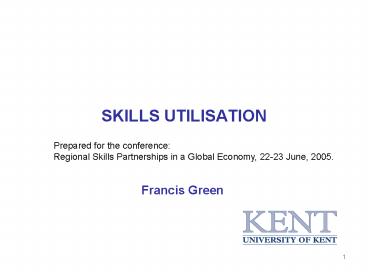SKILLS UTILISATION - PowerPoint PPT Presentation
1 / 22
Title:
SKILLS UTILISATION
Description:
13. 14. Individual Mismatch. 15. Sustainability of College Premium? 21 ... 25-29 Year-Olds. Source: Walker and Zhu (2005). 16 ... of low-skilled jobs ... – PowerPoint PPT presentation
Number of Views:44
Avg rating:3.0/5.0
Title: SKILLS UTILISATION
1
SKILLS UTILISATION
Prepared for the conference Regional Skills
Partnerships in a Global Economy, 22-23 June,
2005.
- Francis Green
2
Outline
- Evidence of rising skills demand in the
knowledge economy - Direct and indirect
- Evidence about the match between skills supply
and demand - A framework for considering policy about skills
utilisation
3
Degrees Increasingly Held
4
Degrees Increasingly Required
5
Short Learning Times Have Shrunk
6
Changes in Computing Skills, 1997-2001
7
Changes in other generic skills 1997-2001
8
Skills are Valued in the Labour Market 1
Batchelors Degree Wage Premium (over 2 A-Levels)
Men 22 Women 35
No trend 1996-2003
9
Skills are Valued in the Labour Market 2
Examples how using a skill is associated with
higher pay
Example 1 Someone with A-level of equivalent
as their highest qualification Those using
computers only in a very simple way or not using
them at work 8.24 hourly pay Those
using computers with at least a moderate level
of sophistication 10.08 i.e. about 22
more.
Example 2 Degree holder Jobs where making
speeches/presentations very important or
essential 17.12 Other degree-holders jobs
14.21.
10
Task Discretion Index 1992, 1997 2001
11
Skills Mismatches Shortages and Under-Utilisation
- Shortages
- around 4 have skills-shortage vacancies
- around 1 in 5 establishments have skills gaps,
implying roughly 1.5 million employees judged by
their managers to have insufficient skills - recent trend stable/edging downwards slightly
- But some occupations suffer more than others
- skilled trades, caring occupations, sales and
customer service occupations, elementary
occupations, business professionals
12
(No Transcript)
13
(No Transcript)
14
Individual Mismatch
15
Sustainability of College Premium?
Source Walker and Zhu (2005).
16
Skills polarisation
- Fastest growing occupations
- At the top consistent with the knowledge
economy - At the bottom
- security and protective service workers in the
business services industries - window dressers, floral arrangers and telephone
sales persons in the hotel and catering industry - matrons, house parents, welfare, community and
youth workers in the public administration and
sanitation industries
17
In short
- skills demand has been growing on average
- there are ongoing skills shortages reported by
employers - and some generic skills have acquired a special
shortage value in the labour market - BUT
- there is also a growth of low-skilled jobs
- at all levels, there is a decline in discretion,
usually associated with skill - there are increasing numbers of people apparently
under-using their qualifications - may be becoming more acute with the rising supply
of qualified workers
18
What can management do?
- take long-term viewpoint
- consider moves into high-value added sectors
these require greater analytical skills, as well
as a commitment to investment in new technologies - integrate skills planning with business strategy
19
What can government do to raise skills
utilisation?
- Influence demand
- Influence supply
- Influence the supply-demand match
20
Supply leading demand
- Can an abundant supply of skilled labour
stimulate increased utilisation of skilled
labour? - Pro e.g. early adoption of computerisation in
the US - Con long-run strategy is uncertain, and has
short-run costs (wages below expectations
dissatisfaction resource waste) potentially
greater at regional level
21
Affecting demand as well as supply
- The state and the economy
- Advocacy
- Business advice services
- Industry standards/kite marks etc.
- State employment
22
Matching services
- encouraging linkages between enterprises and
HE/FE - strategic planning of life-long learning services
to meet local demands - information, advice and guidance services for
individuals - work-life balance and other policies that promote
flexibility































